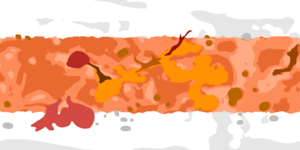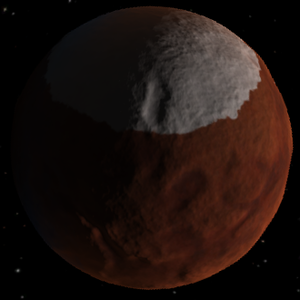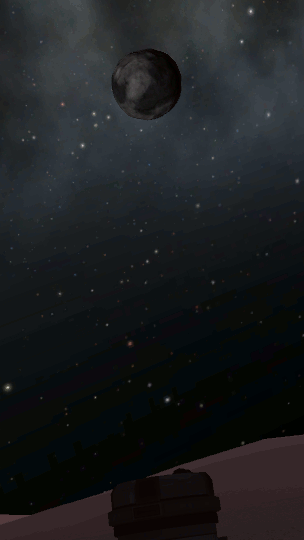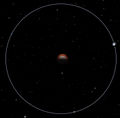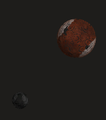Duna
| Duna | ||
| Duna as seen from orbit. | ||
| Planet of Kerbol | ||
| Orbital Characteristics | ||
| Semi-major axis | 20 726 155 264 m [Note 1] | |
| Apoapsis | 21 783 189 163 m [Note 1] | |
| Periapsis | 19 669 121 365 m [Note 1] | |
| Orbital eccentricity | 0.051 | |
| Orbital inclination | 0.06 ° | |
| Argument of periapsis | 0 ° | |
| Longitude of the ascending node | 135.5 ° | |
| Mean anomaly | 3.14 rad (at 0s UT) | |
| Sidereal orbital period | 17 315 400 s | |
| 801 d 3 h 50 m 0.1 s | ||
| Synodic orbital period | 19 645 697.3 s | |
| Orbital velocity | 7 147 - 7 915 m/s | |
| Physical Characteristics | ||
| Equatorial radius | 320 000 m | |
| Equatorial circumference | 2 010 619 m | |
| Surface area | 1.2867964×1012 m2 | |
| Mass | 4.5154270×1021 kg | |
| Standard gravitational parameter | 3.0136321×1011 m3/s2 | |
| Density | 32 897.302 kg/m3 | |
| Surface gravity | 2.94 m/s2 (0.3 g) | |
| Escape velocity | 1 372.41 m/s | |
| Sidereal rotation period | 65 517.859 s | |
| 3 d 0 h 11 m 57.9 s | ||
| Solar day | 65 766.707 s | |
| 3 d 0 h 16 m 6.7 s | ||
| Sidereal rotational velocity | 30.688 m/s | |
| Synchronous orbit | 2 880.00 km | |
| Sphere of influence | 47 921 949 m [Note 1] | |
| Atmospheric Characteristics | ||
| Atmosphere present | Yes | |
| Atmospheric pressure | 6.75500 kPa | |
| 0.066667 atm | ||
| Atmospheric height | 50 000 m | |
| 6.7×10-8 atm | ||
| Temperaturemin | -123.15 °C 150 K | |
| Temperaturemax | -40.15 °C 233 K | |
| Oxygen present | No | |
| Scientific multiplier | ||
| Surface | 8 | |
| Splashed | N/A | |
| Lower atmosphere | 5 | |
| Upper atmosphere | 5 | |
| Near space | 7 | |
| Outer space | 5 | |
| Recovery | 5 | |
|
| ||
Duna is the fourth planet of the Kerbol star system and Mars analog for Kerbal Space Program. It is mostly red with polar icecaps and has one natural satellite, the moon Ike. Ike's size and proximity tidally locks it and Duna to each other.
With proper aerobraking, a round trip from Kerbin to Duna's orbit and back requires roughly 1700 m/s of delta-v, less than a round trip to any other planet. Duna is often the easiest planet to encounter because its orbital inclination is low.
There is a tutorial about Traveling to Duna and Back.
Contents
In-game Description
| “ | Also known as the red dot that you can see if you squint at it really hard, Duna has long been a wonder to Kerbalkind. The planet has been held in much awe due to its striking red color and stark contrast to the color green. — Kerbal Astronomical Society |
” |
Topography
Duna's terrain ranges in altitude from 124 to 8264 meters. Its mountain ranges are a peril to landing craft, due to their steepness and the limited aerobraking that is possible in Duna's tenuous atmosphere at such altitudes.
Duna has several craters. They appear quite eroded, presumably by the wind.
Several maria (large regions of dark soil) are at exactly 0 meters altitude (deprecated). Their low altitude allows for more aerobraking, and the flatness of the terrain makes them easy but boring landing locations. These may have been lakes when the planet may have had liquid on its surface in the past.
Duna's surface contains anomalous features.
Biomes
Duna has 5 biomes.
Biome list
|
Atmosphere
Duna has a thin, cool atmosphere with a mass of approximately 8.9×1015 kilograms, a datum level pressure of 20.265 kilopascals (0.2 atmospheres), and a depth of 50,000 meters. Compared to the atmsophere of Kerbin, Duna's atmosphere has 1/5th the mass and 1/5th the surface pressure. The datum level pressure on Duna is equivalent to that at an altitude of 9,377 m on Kerbin. The pressure at the top of Duna's highest mountain peak is only 7 kPa.
The average molecular weight of Duna air is 14 g/mol, and its adiabatic index is 1.20. This low molecular weight is difficult to explain — because of Duna's low gravity, it should not be possible to retain the lightweight gases necessary to produce such a low molar mass. This low molar mass also means that the density of Duna air at the surface is only 1/9th the density of Kerbin air.
Like all other atmospheres in the game, Duna's atmosphere fades exponentially as altitude increases. The scale height varies with altitude, which is a change from pre-1.0 versions of the game. The pressure-altitude profile is globally constant and independent of temperature. The following table gives the atmospheric pressure at various altitudes above sea level.
| Altitude (m) | Pressure (Pa) |
|---|---|
| 0 | 20 265 |
| 2 500 | 15 247 |
| 5 000 | 11 148 |
| 7 500 | 7 882 |
| 10 000 | 5 363 |
| 15 000 | 2 150 |
| 20 000 | 722.9 |
| 25 000 | 278.3 |
| 30 000 | 108.0 |
| 40 000 | 26.80 |
| 50 000 | 0 |
The surface of Duna is cold, with a globally averaged datum level temperature of approximately -23 oC. Air temperatures decrease with increasing altitude to an altitude of 30 km. Between the altitudes of 30-45 km lies an isothermal layer, having a temperature of -123 oC.
Air temperatures vary with latitude and time of day. At the equator, datum level temperatures vary between a nighttime low of -20 oC and a daytime high of -2 oC. At the poles, the temperature varies between -90 oC and -85 oC. Since Duna has no axial tilt, there are no seasonal temperature variations.
Duna's atmosphere appears to have a reddish or brownish color, both from the surface and from space. The atmosphere has this color even over the poles, where the surface is white.
Atmospheric Flight
The thickness of Duna's atmosphere makes it suitable for aerobraking and the use of parachutes. Although parachutes will deploy on Duna, the atmosphere is so thin that they are usually unable to slow a craft to a safe landing velocity and must be assisted with engines. Parachute performance can be particularly troubling when attempting to land in highland areas.
Below 5 km Duna's atmosphere is thick enough to allow wings to generate enough lift for aerodynamic flight. Jet engines don't work for want of oxygen, but other propulsion methods work well. Performing a horizontal landing with a plane is also possible.
An ascent to Low Duna Orbit from the surface typically requires around 1500 to 2000 m/s in Delta-V to reach a 50 km altitude traveling at roughly 950 m/s.
Orbital Statistics
The synchronous orbit of Duna is at an altitude of 2 880.00 km above Duna. The speed of the satellite is 306.88 m/s and it has an orbital period resonating with 1 Duna day (18.2 hours or 65517.859375 seconds). However, this is the same altitude at which Ike orbits, so unless a ship's orbit is perfectly precise, it will eventually be captured by Ike.
For a semi-synchronous orbit of ½ Duna day (9.1 hours or 32758.9295 seconds) an orbit of 1 695.87 km above Duna is needed with a velocity of 386.65 m/s.
Observation of Ike
Ike's orbit keeps it directly above a short range of Dunar longitudes. The average Duna longitude that Ike tends to stay directly above (at the Zenith) is 6 degrees east, but the eccentricity of Ike's orbit causes the exact longitude to oscillate between about 2 degrees and 10 degrees east and makes Ike appear to grow slightly larger and smaller to an observer on the surface of Duna. The latitude at which Ike is in the Zenith also oscillates between 0.2 degrees south and 0.2 degrees north due to Ike's orbital inclination, making Ike appear to rotate upwards and downwards as viewed from the surface, but due to the extremely small orbital inclination, this effect is nearly imperceptible. These phenomena together are known as libration. The oscillation in Ike's position above the horizon allows areas from 88°W to 80°W and 92°E to 100°E on Duna to observe Ike rise and set at least partially across the horizon, as can any areas north of 89.8°N or south of 89.8°S.
Interplanetary Travel
From altitude orbit around Duna, the delta-V needed to reach the orbits of other celestials is:
| Body | Delta-V | |
|---|---|---|
| Ike | ~300 m/s | |
| Kerbin | ~620 m/s | |
| Dres | ~820 m/s | |
| Eve | ~1080 m/s | |
| Jool | ~1350 m/s | |
| Eeloo | ~1580 m/s | |
| Moho | ~2100 m/s | |
Reference Frames
| Time warp | Minimum Altitude |
|---|---|
| 1× | Any |
| 5× | 50 000 m (above the atmosphere) |
| 10× | 50 000 m (above the atmosphere) |
| 50× | 60 000 m |
| 100× | 100 000 m |
| 1 000× | 300 000 m |
| 10 000× | 600 000 m |
| 100 000× | 800 000 m |
Gallery
Duna at sunrise
Changes
- Added biomes
- Art Pass
- Minor art pass
- Initial Release
Trivia
- According to former developer NovaSilisko, Duna's appearance was inspired by the theory that ice ages on Mars may have brought the ice caps much closer to its equator. [1]
- Duna's name may be either a reference to its desert landscape or a reference to the Frank Herbert novel Dune.
- The low-lying areas near Duna's equator make a shape resembling Europe.
- On the surface of Duna, there is a large monument carved in the likeness of a Kerbal face, alluding to the infamous "Face of Mars" discovered in the Cydonia Mensae region of Mars during the 1970's.
- Buried deep under the surface, there is a small camera, similar to the design on the Curiosity rover.
- One anomalous feature on Duna is a small, pyramid-like hill emitting an SSTV signal. When decrypted, it shows a diagram-like image of three figures standing next to the hill itself, implying that Duna was once inhabited or visited before.
Notes
- ↑ NovaSilisko's answer in “Duna's ice caps are too big”.


